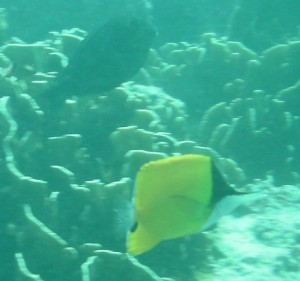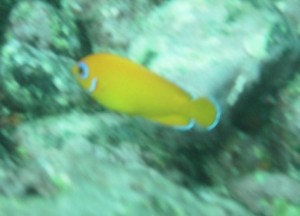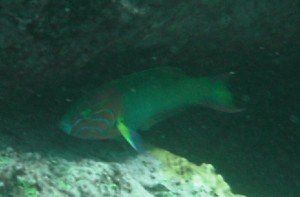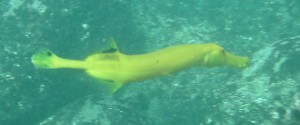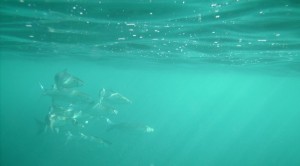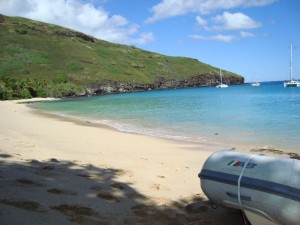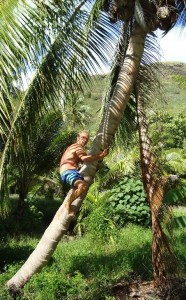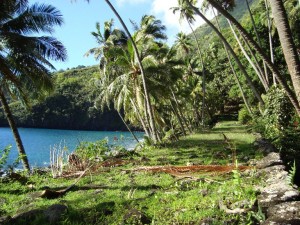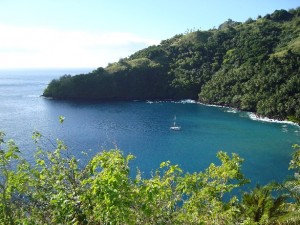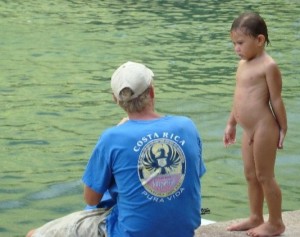After changing the batteries twice, the underwater camera was working just fine again, so Lauren and I jumped in and headed back to the cliffs to get some fish pictures while Wes and Tiff swam up to the beach. Taking underwater photographs when you’re still a novice free diver is a fun challenge. Unfortunately, the fish don’t understand the purpose of the endeavor and in general, the more bright and interesting-looking the fish, the more skiddish, and evasive. The problem here is that the camera needs to be much closer than a diver to “enjoy” the view. Out of 40 or so pictures, no more than half were in focus and not blurry, and there were only two that I thought were really good, although several others weren’t bad. We look forward to posting them soon.
Wes and Tiff made a scrumptious casserole for dinner incorporating leftover noodles from last night’s pasta, potatoes, corn, cream of mushroom, and cheese. It seemed like we were all in the mood for a quiet, early evening.
This morning Lauren and I rowed ashore to stock up on limes and coconuts before leaving Hanamoenoa Bay. The crew on Independence had told us they were having some Marquesans over for lunch today, so we stopped by on the way ashore to get the scoop. They were about to head over to Vaitahu (Resolution Bay) to pick them up, but we found out later that the daughter of the primary guest had cut her leg on some coral, the cut had become infected, and they’d had to take her to the hospital in Atuona, so the get-together on the beach would be only cruisers. (I think before I mentioned that the population of Atuona was 2,600, but it’s actually only 1,600 or so. Even at that size, it’s the second largest town in the Marquesas).
Hanamoenoa Bay is uninhabited, although there is a fenced-in area in the middle of the beach and a structure inside for drying copra. Copra is the dried meat of the coconut and is a primary cash crop here. In the morning, a boat with a few Marquesans came to the bay and started a fire in the copra-drying structure and left a few hours later. Anyway, after all that digression, Lauren and I ended up on the beach relatively early in the morning.
Ahh yes, one more digression. This morning during breakfast Lauren and I could see the spires of Ua Pou (65 miles away) on the clear horizon. We’ve seen a couple of pics and can’t wait to get there in a few days. Now to get back on track.
We walked along the beach and back into the woods a little bit. We picked up a few coconuts of the ground that made a sloshing sound when we shook them (still good water & meat inside) and picked 15 or 20 limes. Our stock of fresh fruit on the boat now includes a stalk of bananas hanging at the stern of the boat (bought from Alec), several pamplemousse (Alec), four coconuts (scavenged in Hanamoenoa), a pineapple (gift from the Swedes), and a bunch of limes (picked in Hanamoenoa). There’s something very satisfying about pulling a banana off the stalk anytime you want to. I tried climbing a tree for a young, green coconut with sweet milk inside. This is reported to be a really great drink and we saw one green coconut on the beach that looked like it had been cut open and emptied only the day before. Anyway, I picked out what I was sure would be an easy opportunity — a coconut tree with more than a dozen nuts hanging no more than 20 feet from the ground. This was also one of those trees that was growing at an angle instead of straight up, so I thought it wouldn’t be too bad to climb. I made it about 6 or 8 feet before I gave up in exhaustion. I could blame it on the lack of exercise on the boat, but climbing a coconut tree is both hard work and quite a skill. I had to settle for getting one of the more mature nuts to fall after hitting it with a small coconut thrown from the ground. Speaking of getting the coconut to fall, in addition to the coconut trees (some of which are at least 60-80 feet tall), there are numerous other fruit and at least one nut tree here. It’s not at all unusual to be walking along and hear something crash to the ground after dropping from high overhead. I asked Alec if the tall coconut trees were dangerous. I think his answer was that a good headache from a falling coconut was a rare but possible occurrence but that no serious injuries resulted from falling fruits & nuts.
Anyway, back on the boat I of course had to de-husk the coconut immediately to learn whether we scavenged something worth eating or just some rotten coconuts. Actually, immediately is a bit of an overstatement. About 15 or 20 minutes later, after Lauren read some tips from a book and I’d been after the thing for a while with a machete, screwdriver, and hammer, we finally had a glass of coconut water and a bowl full of coconut meat. The water was slightly sweet — drinkable but not delicious, just what you’d expect from an older nut. Of course, having just returned from an uninhabited tropical beach with fresh-picked limes and coconuts, I had no choice but to “put the lime in the coconut, put them all together, put the lime in the coconut and then you feel better, put the lime in the coconut and drink ’em both down” (paraphrasing). Strange as it may sound, coconut water and fresh-squeezed lime juice does actually taste like something that would make you feel better if you had an upset stomach.
We hadn’t yet learned about Felix’s daughter having to go to the hospital, so we killed some time by rigging the spinnaker halyard as a rope swing. Actually, we just cleated it off so that one end was about 5 feet off the deck and then ran off of the coach roof holding onto it and swinging out over the clear turquoise water before letting go and falling in. Good fun.
In the early afternoon, we hoisted the anchor and headed south for Hapatoni Bay, where local artisans carve wood and bone. We still aren’t tired of the stunning view of the green mountainsides descending into black cliffs that disappear into the Pacific. Along the way we motorsailed by Vaitahu Bay (Resolution Bay, also Prostitution Bay). The name Resolution Bay was given by Captain Cook, and it is pretty cool to seen a place that Cook sailed to, especially one that above an elevation of a few hundred feet looks much the same as he and his crew first saw it. The Marquesas had a population of roughly 100,000 when the first Europeans arrived, but shrank to a low of 2,000 as a result. The name Prostitution Bay came out of an incident between the French and Marquesans early in the colonial period. The Marquesans were busy building a fort for the French (I know, it’s priceless) when a French soldier raped a Marquesan girl, and a Marquesan warrior killed several French soldiers in an act of revenge. The French insisted on having the murderer turned over, but the chief refused and pulled all of the workers into the mountains, halting construction. When the chief’s life was threatened, his daughter offered herself for his life and an end to the conflict. Ultimately, the warrior surrendered. Understandably, the memorial that commemorates the death of the French soldiers in Vaitahu is very subdued.
After a couple of hours we made it to Hapatoni and anchored in a pretty scary anchorage in the sister bay to the north. All the books say to anchor here and that it is better than Hapatoni, but we seem pretty close to the rocks because the water depth increases so qukcly away from the shore that we have to be very close to be in water shallow enough to anchor. The dinghy engine, which hadn’t been used since Key West, started better than ever and ran great, but not without some adventure. Yours truly hadn’t started the engine in a while and I forgot one key part of the sequence: make sure the engine is in neutral. When the engine started on the second pull, it was in reverse and at full throttle. I shot back and banged into the boat. I tried to shift into neutral and overshot into forward, lurching away from the boat and straining the line holding the dinghy, so I pulled the “key” that kills the engine and the short but frightening ride was over.
The village of Hapatoni itself is a quiet one nestled here at the southwest tip of Tahuata. The entire population of the island is 600, with most at Vaitahu. There seem to be 50-100 people living here. An ancient stone road/seawall that runs along the long beach makes for a beautiful walk. A few people were at the wharf returning in small boats or swimming. A couple young men were sitting on a grassy area overlooking the ocean with a boombox between them and a fresh octopus laying on the ground beside them. A few men were sitting and talking in the woodcarver’s shed, an open-air shed right on the beach with a stone floor and tin roof with solid, beautifully carved wood pillars. There were a number of people, mostly women, in what seemed to be a public, mostly open-air building playing BINGO. Next to this building was a large and well-preserved ancient site. There were numerous levels working higher as it receded from the beach. We saw a “workbench” rock that Alec had shown us was used to make stone tools, several “tattoo parlor” rocks with their two cups ground into a large boulder, and a 4′ x 4′ flat-faced boulder with a face carved into it.
As a side note, I do have to say that at in these more remote reaches of the planet, clothing on children, especially boys, is considered very much optional among company and in public to a much older age than in the states. Just another one of those funny differences. In the US, designer clothes for infants on up aren’t at all difficult to find, and a young child’s dress is often taken as a reflection on the mother. Here, it’s not at all unusual to see a naked three year old playing in the ocean, running on the beach, or wandering around the deck of a boat. I don’t know at what age children in clothing-not-optional societies begin to understand the impropriety of their natural state, but it’s well after they can carry on a simple conversation. Today in Hapatoni we had a really cute, naked local boy who was swimming in the ocean at the wharf with friends and family follow us to our dinghy which was tied up there. We were preparing to head back to the boat and he was querying me about the boat and where we were going. He was fairly serious about figuring it all out, but my French wasn’t quite up to explaining it well enough, and our boat wasn’t visible from the wharf. Oh well.
For those of you who made it to the end, happy Monday. I noticed the other day that the blog site gets 1 1/3 to 2x as many requests Monday-Friday as it does on the weekend. We’re glad to provide a diversion. Hope the blog wasn’t so long as to make you late to a conference room meeting. You can always load the site on your Blackberry and read it during the meeting…


